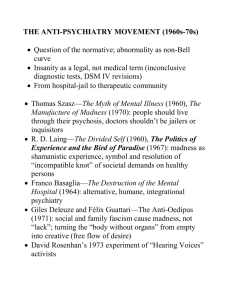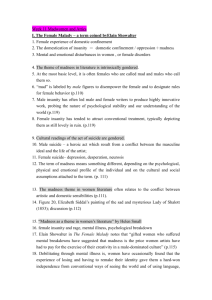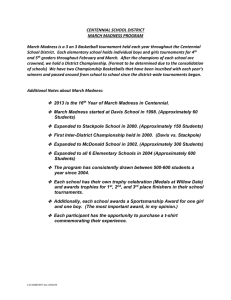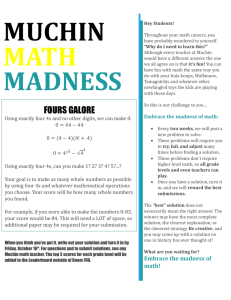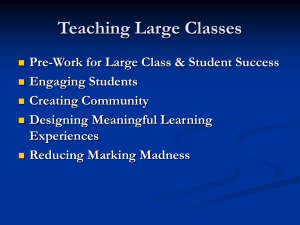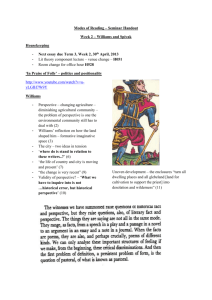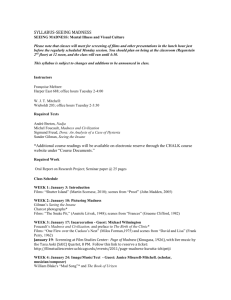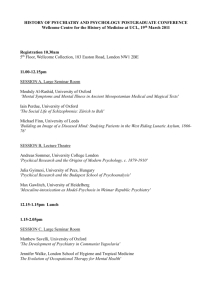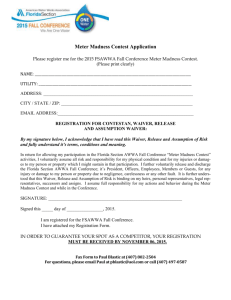madness and its social milieu in britain, 1560-1820
advertisement
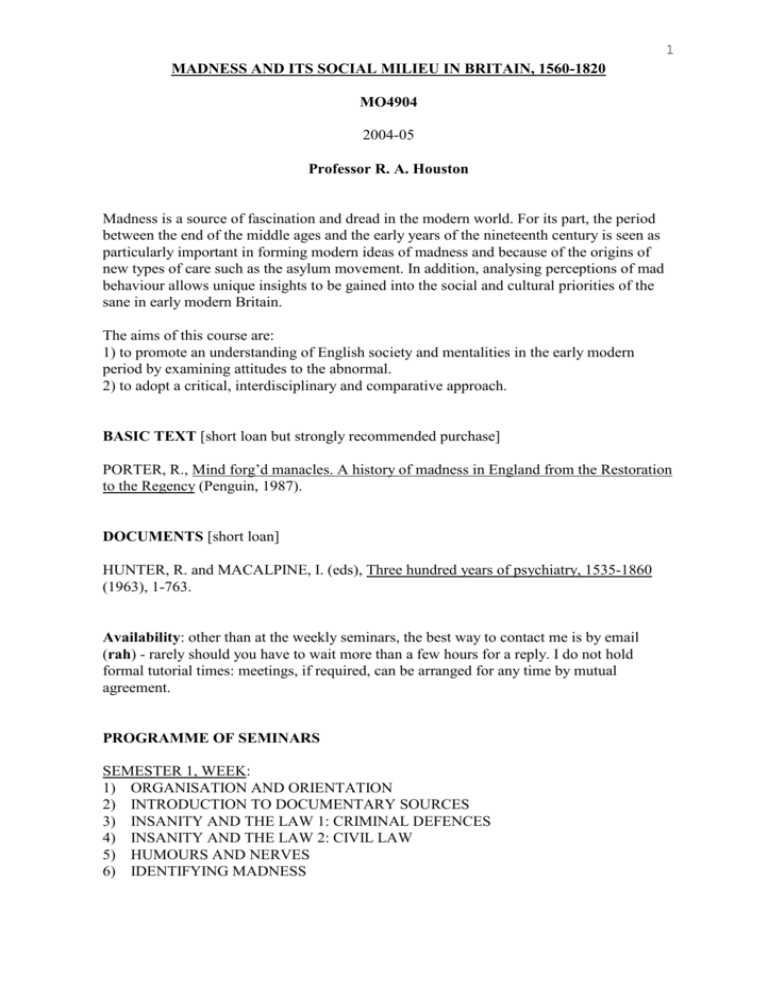
1 MADNESS AND ITS SOCIAL MILIEU IN BRITAIN, 1560-1820 MO4904 2004-05 Professor R. A. Houston Madness is a source of fascination and dread in the modern world. For its part, the period between the end of the middle ages and the early years of the nineteenth century is seen as particularly important in forming modern ideas of madness and because of the origins of new types of care such as the asylum movement. In addition, analysing perceptions of mad behaviour allows unique insights to be gained into the social and cultural priorities of the sane in early modern Britain. The aims of this course are: 1) to promote an understanding of English society and mentalities in the early modern period by examining attitudes to the abnormal. 2) to adopt a critical, interdisciplinary and comparative approach. BASIC TEXT [short loan but strongly recommended purchase] PORTER, R., Mind forg’d manacles. A history of madness in England from the Restoration to the Regency (Penguin, 1987). DOCUMENTS [short loan] HUNTER, R. and MACALPINE, I. (eds), Three hundred years of psychiatry, 1535-1860 (1963), 1-763. Availability: other than at the weekly seminars, the best way to contact me is by email (rah) - rarely should you have to wait more than a few hours for a reply. I do not hold formal tutorial times: meetings, if required, can be arranged for any time by mutual agreement. PROGRAMME OF SEMINARS SEMESTER 1, WEEK: 1) ORGANISATION AND ORIENTATION 2) INTRODUCTION TO DOCUMENTARY SOURCES 3) INSANITY AND THE LAW 1: CRIMINAL DEFENCES 4) INSANITY AND THE LAW 2: CIVIL LAW 5) HUMOURS AND NERVES 6) IDENTIFYING MADNESS 2 7) 8) 9) 10) 11) 12) reading week ATTRIBUTING THE CAUSES OF INSANITY MADNESS, CLASS AND GENDER MADNESS AND RELIGION gobbets week MADNESS AND SUICIDE SEMESTER 2, WEEK: 1) 2) 3) 4) 5) 6) 7) 8) 9) 10) 11) 12) THE CARING PROFESSIONS THERAPEUTIC REGIMES FAMILY AND COMMUNITY BETHLEHEM HOSPITAL THE ORIGINS OF THE ASYLUM gobbets week THE ILLNESS OF KING GEORGE MADNESS, ART, AND LITERATURE THE VOICE OF THE MAD MADNESS AND SANITY RELATIVISM AND POSITIVISM student revision WORKLOAD Three seminar papers of no more than 2,000 words each and three sets of commentaries on document extracts (each equally weighted) will make up 40% of the final mark, the other 60% being made up by two three hour examinations. All course-work must be wordprocessed and submitted in hard copy. Each week we shall have a student essay which will be presented in class with a one page A4 handout for each member of the class. Gobbets will be prepared as follows. In weeks when you are not doing an essay, you may be asked to prepare and present a document extract. You will have to do two such presentations (with a handout) making up one gobbet mark. Specific assignments will be handed out once essays have been allocated. The other two will be writing 500 words each on two from six gobbets (emulating the format of Paper 1 in the exams). You will do two such assignments. The first will be in your own time and will be submitted by 4pm on Friday 5th December (week 10) of first semester. These gobbets will be discussed in the following week’s class. The second set you will prepare in your own time, but write under exam conditions in the class on Wednesday 17th March (week 6 of second semester). Course work makes up a total of 40% of your mark for the module. The other 60% is generated by two three-hour exams at the end of the second semester, in which you will be required to write on nine gobbet extracts (three from a choice of six in each of three questions) [paper I] and on three out of the nine essay questions set [paper II]. These exams usually take place on the same day during the May/June diet. You should familiarise yourself with examples of past exam papers, available from the University Library or the class/School website. 3 Seminars and Written Work The course is taught by seminars, which will take place weekly on Wednesday 10am-noon in room 0.06 of St Katharine’s Lodge during semesters 1 and 2, as specified below (but please note that there will be no teaching in week 7 of semester 1, which is university reading week). They will normally be based on student papers. Attendance is compulsory and there are penalties for delinquency in attendance and submission of written work. You can familiarise yourselves with these at: http://www.st-and.ac.uk/academic/history/information/permission.shtml Unless otherwise specified in writing the deadline for all written work is noon on Monday for essays or gobbet presentations scheduled for that week’s Wednesday seminar. School regulations state that late work will be penalised. http://www.st-andrews.ac.uk/academic/history/information/late.shtml Seminars topics are listed below along with 1) pages on which some relevant documents will be found: these are only a starting point in your search for relevant extracts 2) a list of secondary reading which refers to the course Bibliography (available on the Internet via my homepage) 3) essay titles SEMESTER 1, WEEK: 1) ORGANISATION AND ORIENTATION 2) DOCUMENTARY SOURCES Hunter and Macalpine: flick through the lot! Bartlett (2001). Ingram (1991). MacDonald (1987). Macfarlane (1977). 3) INSANITY AND THE LAW 1: CRIMINAL DEFENCES Hunter and Macalpine: 42-5, 436-7, 557, 563-4, 567-72, 576-7, 621-6, 637 Andrews and Scull (2001), ch. 6. Bartlett (2001). Beattie (1986). De Lacy (1986). Eigen (1985), (1991), (1995). Forbes (1985). Hanawalt (1979). Jackson (1995). Macalpine and Hunter (1969), ch. 23. Manning (1993). Robinson (1995). Rushton (1988). Smith (1981). Walker (1968). What developments took place in criminal insanity defences during the period 1700-1820? 4) INSANITY AND THE LAW 2: CIVIL LAW 4 Hunter and Macalpine: 64-5, 92, 103-5, 137-40, 278, 297, 299-301, 373-5, 434-5, 451-7, 611-13, 617-20, 696-703, 706-7 Bartlett (1999), ch. 1-2. Bartlett (2001). Davies (1996a, 1996b). Horowitz and Polden (1996). MacDonald (1989). Suzuki (1991, 1992). Did the civil law protect the mentally disabled of early modern England? 5) HUMOURS AND NERVES Hunter and Macalpine: 7-11, 50-2, 130-2, 141-2, 189-92, 405-9, 469-71, 475-9, 489-90, 579-83 Bynum (1974), (1985). Koutouvidis and Marketos (1995). Suzuki (1995x2). MacDonald (1981), ch. 2. Skultans (1979), ch. 2. Thomson (1997). Outline how theories explaining mental ailments changed between the late sixteenth and the late eighteenth century. 6) IDENTIFYING MADNESS Hunter and Macalpine: 103-5, 121, 163-5, 182-3, 237-9, 240-3, 258-61, 265-6, 272-3, 3035, 338-41, 373-5, 402-10, 522-4, 532-3, 638-9, 709 Andrews (1990) (1998). Barry (1985). Cope (1987). Digby (1985), ch. 8. Doerner (1981). Eigen (1995), ch. 4. Goodey (1994). Hattori (1995). Jackson (1998). Kromm (1985). Leff 2000. MacDonald (1981), ch. 4. Miller 1996. Rack (1982). Sharpe (1996). Skultans (1979), ch. 6. Suzuki (1991) (1999). Wright and Digby (1996), ch. 2, 4. Do you agree with Klaus Doerner (Madmen and the bourgeoisie, p. 16) that identifying madness was ‘an arbitrary matter’? 7) reading week 8) ATTRIBUTING THE CAUSES OF INSANITY Hunter and Macalpine: 7-9, 36-40, 73, 96-7, 182-3, 245-6, 321-2, 386-8, 425, 487-8, 54851, 576-7, 588-91, 646, 666-7, 691-2 (see IDENTIFYING MADNESS plus) Barry (1985). Digby (1985), ch. 9. MacDonald (1981), ch. 3, (1982). MacDonald and Murphy (1990). Rack (1982). Smith (1999), ch. 3. Why did people choose one cause rather than another when explaining the madness of friends or family, patients or strangers in early-modern England? 9) MADNESS, CLASS AND GENDER Hunter and Macalpine: 221-3, 231-2, 289-91, 729-30 (see also IDENTIFYING MADNESS and ATTRIBUTING …) 5 Andrews 1990. Digby 1985. Doerner (1981). Foyster 2002. Jackson 1995. MacDonald 1981. Micale 1989. Neely 1991. Rousseau 2000. Showalter 1987. Small 1996. Suzuki 1998. Williams (1990). Were criteria of madness ‘male and bourgeois’ in early modern England? 10) MADNESS AND RELIGION Hunter and Macalpine: 60-1, 66-7, 71-5, 164-5, 241-3, 252, 321-2, 528-31, 550-1 (see IDENTIFYING MADNESS plus) Doerner (1981). Guy (1982). Harley (1989), (1994). Laffey 2001. Scull (1979), (1993). Did the witches of the sixteenth and seventeenth century become the mad people of the eighteenth and early nineteenth century? 11) gobbets week 12) MADNESS AND SUICIDE Hunter and Macalpine: 113-15, 154-7, 166-7, 226, 528-31, 536, 563-4, 589, 645, 666 Barry (1985). MacDonald and Murphy (1990). Murphy (1986). Murray, 1998, 2000. Seabourne & Seabourne, 2000, 2001. Seaver (1985). Stevenson (1987 x 2). Zell (1986). Did an automatic connection between suicide and madness develop in late seventeenth and eighteenth century England? SEMESTER 2, WEEK: 1) THE CARING PROFESSIONS Hunter and Macalpine: 59-61, 64-5, 91, 279-81, 293-5, 369-70, 425, 542, 637, 654-5 (plus CARE 2 & 5) Andrews (1990). Andrews and Scull (2001). Carpenter (1989). Digby (1985), ch. 6, (1994). Eigen (1985) (1995). Forbes (1985). Guy (1982). Harley (1994). Holmes (1982). Landsman (1998). Melling and Forsythe (1999), ch. 6. Porter, D. (1989). Porter, R. (1989). Porter and Porter (1988). Rosner (1991). Scull (1993). Smith (1981). Smith (1999), ch. 2, 4. Did the eighteenth and early nineteenth centuries see the development of a psychiatric profession? 2) THERAPEUTIC REGIMES Hunter and Macalpine: 55-8, 122-3, 184-6, 191-2, 209-11, 225-6, 233-5, 248-51, 272-3, 282-4, 294-5, 311-14, 325-9, 333-4, 346-7, 376-8, 408-10, 421-2, 449-50, 535-7, 596-8, 600-1, 635-6, 644-7, 651-2, 671 6 Andrews (1991). Andrews and Scull (2001). Brewer and Porter (1993). Digby (1985), ch. 34. Macalpine and Hunter (1969), ch. 17-21. MacDonald (1981), ch. 5. Smith (1993). Smith (1999), ch. 6. How much did therapies for mental ailments change in the early modern period? 3) FAMILY AND COMMUNITY Hunter and Macalpine: 103-5, 137, 139, 248-51, 299-301, 472, 525-7 Andrews (1988). Bartlett and Wright (1999). Beier (1985). Fessler (1956). Macalpine and Hunter (1969), ch. 24. Mason (1994). Murphy 2001. Rushton (1988). Smith (1988), (1992), (1993), (1994). Suzuki (1991), (1992), (1998). Wright and Digby (1996), ch. 3. What support was available to the mentally disabled outside formal institutions (asylums, poorhouses or jails)? 4) BETHLEHEM HOSPITAL Hunter and Macalpine: 40-1, 102, 106-8, 235, 302-10, 355-7, 414-15, 644-7, 696-703 Allderidge (1979), (1985). Andrews et al (1997). Porter (1988). Stevenson (1996). MULTIMEDIA RESOURCES. How typical was Bethlem of the care given to the mentally troubled in early modern England? 5) THE ORIGINS OF THE ASYLUM Hunter and Macalpine: 200, 265-7, 277, 330-1, 366-7, 427-9, 445-8, 451-57, 472, 517-20, 525-7, 542, 606-10, 621-6, 629-30, 687-90, 706-7, 723-5 Andrews (1995). Bickford (1976). Digby (1983), (1985), (1986). Ignatieff (1983). Jones (1993). Macalpine and Hunter (1969), ch. 23. ). Melling and Forsythe (1999), ch. 2. Murphy 2001. Parry-Jones (1971). Philo (1995). Porter (1992). Scull (1979), (1993). Smith (1996), (1999), ch. 1. Winston (1994). MULTI-MEDIA RESOURCE 3. Why were more institutions for the mentally disabled opened in England c.1700-1820? 6) gobbets week 7) THE ILLNESS OF GEORGE III Hunter and Macalpine: 510-14, 672-5 Arnold (1996). Christie (1986). Macalpine and Hunter (1969), ch. 1-16. Reid (1992). Walker (1968), ch. 4, 11. MULTI-MEDIA RESOURCES 1, 2. 7 From an historian’s perspective, write a critical review of the ‘The madness of King George’ (FilmFour). 8) MADNESS, ART AND LITERATURE Hunter and Macalpine: 214-15, 298, 320-1, 355-7, 417-18, 599, 676-8, 695 Andrews (1990). Babb (1951). Bynum and Neve (1985). Dickinson 2000. Feder (1980). Grange (1962). Hattori (1995). Herold (1995). Jamison (1993). MacDonald (1986). Neely (1991). Porter (1985). Roberts and Porter (1993), ch. 4. Small (1996). Was art and literature a positive or a negative influence on the national development of attitudes towards the mentally disabled? 9) THE VOICE OF THE MAD? Hunter and Macalpine: 154-7, 174-7, 214-15, 315-18, 322, 358-63, 397, 417-18, 544-6 Eigen (1995), ch. 7. Hodgkin (2001) x 2. Ingram (1982) (1991) (1998). Keynes (1995). Peterson (1982). Porter (1996). How did the mentally troubled of seventeenth- and eighteenth-century England understand their condition? 10) MADNESS AND SANITY Hunter and Macalpine: 17-19, 47-9, 64-7, 76-7, 100-1, 116-7, 129, 209-11, 278, 373-5, 388, 458-61, 546, 661 Beier (1985). Foucault (1971). Gaskill 2000. Gutting (1994). Hattori (1995). Jones and Porter (1998). Madden (1967). Walsham (1998). What did it mean to be sane in early modern England? 11) RELATIVISM AND POSITIVISM Bartlett (1999), ch. 7. Berrios (1994). Berrios and Porter (1995). Doerner (1981). Goffman (1968). Kiev (1972). Kleinman and Good (1985). Laing (1960). Macalpine and Hunter (1969), ch. 12, 25-7. Maher (1973). Melling and Forsythe (1999), ch. 1. Moore (1984). Murphy (1976). Romanucci-Ross (1983). Rousseau (1980). Skultans (1979), ch. 1. Stevens and Price (1996). Stevenson (1977). Szasz (1971), (1972). MULTI-MEDIA RESOURCE 4. How does an historian’s understanding of mental incapacity vary from that of a modern psychologist or psychiatrist? READING 8 Warning: if you discover any other items apparently of relevance to the course you should bring them to me for approval, or email me (rah@st-and.ac.uk) with details, before using them in your essays. The reading list may not include all the relevant items in the University Library, but there are a number of titles deliberately excluded as misleading or unscholarly. Students should please note that I never lend out my books or articles. ALLDERIDGE, P. H., ‘Management and mismanagement at Bedlam, 1547-1633’, in WEBSTER, C. (ed.), Health, medicine, and mortality in the sixteenth century (Cambridge, 1979), 141-64. ALLDERIDGE, P. H., ‘Bedlam: fact or fantasy’, in BYNUM, W. F., PORTER, R., and SHEPHERD, M. (eds), The anatomy of madness. Essays in the history of psychiatry vol. 2 (London, 1985), 17-33. ANDREWS, J., ‘The lot of the “incurably” insane in enlightenment England’, Eighteenth Century Life 12, 1 (1988), 1-18. ANDREWS, J., ‘“In her vapours ... [or] in her madness”? Mrs Clerke’s case: an early eighteenth century psychiatric controversy’, History of Psychiatry 1, 1 (1990), 125-44. ANDREWS, J., ‘A respectable mad doctor? Dr Richard Hale F. R. S. (1670-1728)’, Notes and Records of the Royal Society of London 44 (1990), 169-204. ANDREWS, J., ‘“Hardly a hospital, but a charity for pauper lunatics”? Therapeutics at Bethlem in the seventeenth and eighteenth centuries’, in BARRY, J. and JONES, C. (eds), Medicine & charity before the welfare state (London, 1991), 63-82. ANDREWS, J., ‘The politics of committal to early modern Bethlem’, in R. PORTER (ed.), Medicine in the enlightenment (Amsterdam, 1995), 6-63. ANDREWS, J. et al, The History of Bethlem hospital (1997). ANDREWS, J., ‘Begging the question of idiocy: the definition and socio-cultural meaning of idiocy in early modern Britain’, History of Psychiatry 9 (1998): (1), 65-95; (2), 179-200. ANDREWS, J. and SCULL, A., Undertaker of the mind: John Monro and mad-doctoring in eighteenth-century England (London: University of California Press, 2001). ARNOLD, W. N., ‘George III’s urine and indigo blue’, Lancet 347 (1996), 1811-13. BABB, L., The Elizabethan malady: a study of melancholia in English literature from 15801640 (Michigan, 1951). BARRY, J., ‘Cultural habits of illness: medicine and religion in eighteenth-century Bristol’, in PORTER, R. (ed.), Patients and practitioners. Lay perceptions of medicine in preindustrial society (Cambridge, 1985), 177-204. 9 BARTLETT, P., The poor law of lunacy: the administration of pauper lunatics in midnineteenth-century England (1999). BARTLETT, P., ‘Legal madness in the nineteenth century’, Social History of Medicine 14 (2001), 107-31. BARTLETT, P. and WRIGHT, D. (eds), Outside the walls of the asylum. The history of care in the community, 1750-2000 (London, 1999), ch. 1, 4, 6, 8. BEATTIE, J., Crime and the courts in England, 1660-1800 (Oxford, 1986), 82-5. BEIER, A. L., Masterless men: the vagrancy problem in England, 1560-1640 (London, 1985), 110-19. BERRIOS, G. E., ‘Historiography of mental systems and diseases’, History of Psychiatry 5 (1994), 175-90. BERRIOS, G. and PORTER, R. (eds), A history of clinical psychiatry. The origin and history of psychiatric disorders (1995). BICKFORD, J. A. R. and M. E., The private lunatic asylums of the East Riding (Beverley, 1976). BREWER, J. and PORTER, R. (eds), Consumption and the world of goods (1993), ch. 4. BURTON, R., The anatomy of melancholy 3 volume edition (Oxford, 1989-94). BYNUM, W. F., ‘Rationales for therapy in British psychiatry: 1780-1835’, Medical History 18 (1974), 317-34. BYNUM, W. F., ‘The nervous patient in eighteenth- and nineteenth-century Britain: the psychiatric origins of British neurology’, in BYNUM, W. F., PORTER, R., and SHEPHERD, M. (eds), The anatomy of madness. Essays in the history of psychiatry vol. 1 (London, 1985), 89-102. BYNUM, W. F., PORTER, R., and SHEPHERD, M. (eds), The anatomy of madness. Essays in the history of psychiatry 2 vols. (London, 1985). BYNUM, W. F., PORTER, R., and SHEPHERD, M., ‘Introduction’, in Bynum, W. F., Porter, R., and Shepherd, M. (eds), The anatomy of madness. Essays in the history of psychiatry vol. 1 (London, 1985), 1-24. BYNUM, W. F. and NEVE, R., ‘Hamlet on the couch’, in BYNUM, W. F., PORTER, R., and SHEPHERD, M. (eds), The anatomy of madness. Essays in the history of psychiatry vol. 1 (London, 1985), 289-304. CARPENTER, P. K., ‘Thomas Arnold: a provincial psychiatrist in Georgian England’, Medical History 33 (1989), 199-216. 10 CHRISTIE, I. R., ‘George III and the historians 30 years on’, HISTORY Vol.71, No.232 (1986), pp.205-221 COPE, E. S., ‘Dame Eleanor Davies: never soe mad a ladie?’, Huntington Library Quarterly 50 (1987), 133-144. DAVIES, T. G., ‘Judging the sanity of an individual: some south Wales civil legal actions of psychiatric interest’, National Library of Wales Journal 29 (1996a), 455-67. DAVIES, T. G., ‘The Welsh contribution to mental health legislation in the nineteenth century’, The Welsh History Review 18, 1 (1996b), 40-62. DE LACY, M., Prison reforms in Lancashire, 1700-1850: a study in local administration (1986), 117-19. DIGBY, A., ‘Changes in the asylum: the case of York, 1777-1815’, Econ. Hist. Rev. 36, 2 (1983), 218-39. DIGBY, A., Madness, morality and medicine: a study of the York Retreat, 1796-1914 (Cambridge, 1985). DIGBY, A., From York lunatic asylum to Bootham Park hospital Borthwick Papers 69 (York, 1986). DIGBY, A., ‘Quantitative and qualitative perspectives on the asylum’, in PORTER, R. and WEAR, A. (eds), Problems and methods in the history of medicine (London, 1987), 153-74. DIGBY, A., Making a medical living. Doctors and patients in the market for medicine, 1720-1914 (1994). DICKINSON, H., ‘Idiocy in nineteenth-century fiction compared with medical perspectives of the time’, History of Psychiatry 9 (2000), 291-309. DOERNER, K., Madmen and the bourgeoisie. A social history of insanity and psychiatry translated by J. NEUGROSCHEL and J. STEINBERG (Oxford, 1981. First published 1969). EIGEN, J. P., ‘Intentionality and insanity: what the eighteenth-century jury heard’, in W. F. BYNUM, R. PORTER and M. SHEPHERD (eds), The anatomy of madness. Essays in the history of psychiatry vol. 2 (London, 1985), 34-49. EIGEN, J. P., ‘Delusion in the courtroom: the role of partial insanity in early forensic testimony’, Medical History 35 (1991), 25-49. EIGEN, J. P., Witnessing insanity. Madness and mad-doctors in the English court (New Haven, 1995). FEDER, E., Madness in literature (Princeton, 1980). 11 FESSLER, A., ‘The management of lunacy in seventeenth century England. An investigation of quarter-session records’, Proceedings of the Royal Society of Medicine 49 (1956), 901-7. FORBES, T. R., Surgeons at the Bailey: English forensic medicine to 1878 (London 1985). FOUCAULT, M., Madness and civilization. A history of insanity in the age of reason translated by Richard Howard (London, 1971). FOYSTER, E., ‘At the limits of liberty: married women and confinement in eighteenthcentury England’, Continuity and Change 17, 1 (2002), 39-62 GASKILL, M., Crime and mentalities in early modern England (Cambridge, 2000). GOFFMAN, E., Asylums. Essays on the social situation of mental patients and other inmates (Harmondsworth, 1968 edition). GOODEY, C. F., ‘John Locke’s idiots in the natural history of mind’, History of Psychiatry 5 (1994), 215-50. GRANGE, K. M., ‘Dr Samuel Johnson’s account of a schizophrenic illness in Rasselas’, Medical History 6 (1962), 162-8. GUTTING, G., ‘Foucault and the history of madness’, in GUTTING, G. (ed.), The Cambridge companion to Foucault (Cambridge, 1994), 47-70. GUY, J. R., ‘The Episcopal licensing of physicians, surgeons, and midwives’, Bulletin of the History of Medicine 56, 4 (1982), 528-42. HALLIDAY, A., A general view of the present state of lunatics, and lunatic asylums, in Great Britain and Ireland, and in some other kingdoms (London, 1828). HANAWALT, B. A., Crime and conflict in English communities, 1300-1348 (1979), 1014, 145-50. HARLEY, D., ‘Mental illness, magical medicine and the devil in northern England’, in FRENCH, R. and WEAR, A. (eds), The medical revolution of the seventeenth century (1989), 114-44. HARLEY, D., ‘The good physician and the godly doctor: the exemplary life of John Tylston of Chester (1663-99)’, Seventeenth Century 9, 1 (1994), 93-117. HATTORI, N. ‘“The pleasure of your Bedlam”: the theatre of madness in the Renaissance’, History of Psychiatry 6 (1995), 283-308. HEROLD, N., ‘Madness and drama in the age of Shakespeare’, Comparative Studies in Society and History 37 (1995), 94-99. HODGKIN, K., ‘The labyrinth and the pit’, History Workshop Journal 51 (2001), 37-63. 12 HODGKIN, K., ‘Reasoning with unreason: visions, witchcraft, and madness in early modern England’, in CLARK, S. (ed.), Languages of witchcraft. Narrative, ideology and meaning in early modern culture (London, 2001), 217-36. HOLMES, G., Augustan England. Professions, state and society, 1680-1730 (1982), ch. 57. HOROWITZ, H. & POLDEN, P., ‘Continuity or change in the Court of Chancery in the seventeenth and eighteenth centuries?’, Journal of British Studies 35, 1 (1996), 24-57. HOUSTON, R. A., Madness and society in eighteenth-century Scotland (2000) [use index for English comparisons]. IGNATIEFF, M., ‘Total institutions and working classes: a review essay’, History Workshop Journal 15 (1983), 167-73. INGRAM, A., Boswell’s creative gloom (London, 1982). INGRAM, A., The madhouse of language: writing and reading madness in the eighteenth century (1991). INGRAM, A. (ed.), Patterns of madness in the eighteenth century: a reader (1998). JACKSON, M., New-born child murder. Women, illegitimacy and the courts in eighteenthcentury England (Manchester, 1995), 120-7. JACKSON, M., ‘“It begins with the goose and ends with the goose”: medical, legal and lay understandings of imbecility in Ingram v Wyatt, 1824-1832’, Social History of Medicine 11, 3 (1998), 361-80. JAMISON, K. R., Touched with fire. Manic-depressive illness and the artistic temperament (New York, 1993). JONES, C. and PORTER, R., Reassessing Foucault. Power, medicine and the body (London, 1998). JONES, K., Asylums and after: a revised history of the mental health services from the early 18th century to the 1990s (1993). KEYNES, M., ‘The personality of Isaac Newton’, Notes and Records of the Royal Society of London 49 (1995), 1-56. KIEV, A., Transcultural psychiatry (New York, 1972). KINSMAN, R. S., ‘Folly, melancholy, and madness: a study of shifting styles of medical analysis and treatment, 1450-1675’, in KINSMAN, R. S. (ed.), The darker vision of the Renaissance (Berkeley, 1974), 273-320. 13 KLEINMAN, A. and GOOD, B., ‘Introduction: culture and depression’, in KLEINMAN, A. and GOOD, B. (eds), Culture and depression. Studies in the anthropology and cross-cultural psychiatry of affect and disorder (London, 1985), 1-33. KOUTOUVIDIS, N. and MARKETOS, S. G., ‘The contribution of Thomas Sydenham (1624-1689) to the evolution of psychiatry’, History of Psychiatry 6 (1995), 513-20. KROMM, J. E., ‘Hogarth’s madmen’, Journal of the Warburg and Courtauld Institutes 48 (1985), 238-42. LAFFEY, P., ‘John Wesley on insanity’, History of Psychiatry 12, 4 (2001), 467-79. LAING, R. D., The divided self. An existential study in sanity and madness (London, 1960). LANDSMAN, S., ‘One hundred years of rectitude: medical witnesses at the Old Bailey, 1717-1817’, Law and History Review 16, 3 (1998), 445-94. LEFF, A., ‘Clean around the bend: the etymology of jargon and slang terms for madness’, History of Psychiatry 11, 2 (2000), 155-62. MACALPINE, I. and HUNTER, R., George III and the mad business (London, 1969). MACDONALD, M., Mystical bedlam. Madness, anxiety, and healing in seventeenthcentury England (Cambridge, 1981). MACDONALD, M., ‘Religion, social change and psychological healing in England, 16001800’, in SHEILS, W. J. (ed.), The church and healing (Oxford, 1982), 101-25. MACDONALD, M., ‘Ophelia’s maimèd rites’, Shakespeare Quarterly 37 (1986), 309-17. MACDONALD, M., ‘Madness, suicide, and the computer’, in PORTER, R. and WEAR, A. (eds), Problems and methods in the history of medicine (London, 1987), 207-29. MACDONALD, M., ‘Lunatics and the state in Georgian England’, Social History of Medicine 2,3 (1989), 299-313. MACDONALD, M. and MURPHY, T. R., Sleepless souls. Suicide in early modern England (Oxford, 1990). MACDONALD, M., Witchcraft and hysteria in Elizabethan London: Edward Jorden and the Mary Glover case (London, 1991). MACFARLANE, A., Reconstructing historical communities (1977). MADDEN, J. S., ‘Samuel Johnson’s alcohol problem’, Medical History 11 (1967), 141-9. MAHER, B., ‘Introduction’, in MAHER, B. (ed.), Contemporary abnormal psychology (Harmondsworth, 1973), 9-15. 14 MANNING, R. J., ‘John Elliot and the inhabited sun’, Annals of Science 50 (1993), 349364. MASON, A., ‘The reverend John Ashbourne (c.1611-61) and the origins of the private madhouse system’, History of Psychiatry 5 (1994), 321-45. MELLING, J. and FORSYTHE, W. (eds), Insanity, institutions and society, 1800-1914. A social history of madness in comparative perspective (London, 1999). MICALE, M. S., ‘Hysteria and its historiography: a review of past and present writings (I and II)’, History of Science 27 (1989), 223-61, 319-51. MIDELFORT, H. C. E., ‘Madness and civilization in early modern Europe: a reappraisal of Michel Foucault’, in Malament, B. C. (ed.), After the Reformation: essays in honor of J. H. Hexter (Philadelphia, 1980), 247-65. MIDELFORT, H. C. E., Mad princes of Renaissance Germany (Charlottesville, Va., 1994). MIDELFORT, H. C. E., A history of madness in sixteenth-century Germany (Stanford, 1999). MILLER, E., ‘Idiocy in the nineteenth century’, History of Psychiatry 7 (1996), 361-73. MOORE, M. S., Law and psychiatry. Rethinking the relationship (Cambridge, 1984). MURPHY, E., ‘Mad farming in the metropolis’, parts 1 and 2 History of Psychiatry 12, 3 & 4 (2001), 245-82, 405-30. MURPHY, J. M., ‘Psychiatric labeling in cross-cultural perspective’, Science 191 (1976), 1019-1028. MURPHY, T. R., ‘“Woful childe of parents rage”: suicide of children’, Sixteenth Century Jnl. 17, 3 (1986), 259-70. MURRAY, A., Suicide in the middle ages 2 vols. (Oxford, 1998, 2000). NEELY, C. T., ‘“Documents in madness”: reading madness and gender in Shakespeare’s tragedies and early modern culture’, Shakespeare Quarterly 42, 3 (1991), 315-38. PARRY-JONES, W. L., The trade in lunacy: a study of private madhouses in England and Wales in the eighteenth and nineteenth centuries (London, 1971). PETERSON, D., A mad people’s history of madness (Pittsburgh, 1982). PHILO, C., ‘Journey to asylum: a medical-geographical idea in historical context’, Journal of Historical Geography 21, 2 (1995), 148-168. 15 PORTER, D., Patient’s progress. Doctors and doctoring in eighteenth-century England (1989). PORTER, R. (ed.), Illustrations of madness by John Haslam (London, 1988). PORTER, R., ‘“The hunger of imagination”: approaching Samuel Johnson’s melancholy’, in BYNUM, W. F., PORTER, R. and SHEPHERD, M. (eds), The anatomy of madness. Essays in the history of psychiatry vol. 1 (London, 1985), 63-88. PORTER, R., Health for sale. Quackery in England, 1660-1850 (1989). PORTER, R. ‘Madness and its institutions’, in WEAR, A. (ed.), Medicine in society: historical essays (1992), 277-301. PORTER, R., ‘Shaping psychiatric knowledge: the role of the asylum’, in PORTER, R. (ed.), Medicine in the enlightenment (Amsterdam, 1995), 255-73. PORTER, R., A social history of madness: stories of the insane (1996). RACK, H. D., ‘Doctors, demons and early Methodist healing’, in SHEILS, W. (ed.), The church and healing (Oxford, 1982), 137-52. REID, C., ‘Burke, the regency crisis, and the “antagonist world of madness”’, EighteenthCentury Life 16 (1992), 59-75. RISSE, G. B., Hospital life in Enlightenment Scotland (Cambridge, 1986). RISSE, G. B., ‘Hysteria at the Edinburgh infirmary: the construction and treatment of a disease, 1770-1800’, Medical History 32, 1 (1988), 1-22. ROBERTS, M. M. and PORTER, R. (eds), Literature and medicine during the eighteenth century (London, 1993), ch. 1, 4. ROBINSON, D. N., Wild beasts and idle humours: the insanity defence from antiquity to the present (Cambridge, Mass., 1995). ROMANUCCI-ROSS, L., ‘Madness, deviance, and culture’, in ROMANUCCI-ROSS, L., MOERMAN, D. E. and TANCREDI, L. R. (eds), The anthropology of medicine: from culture to method (South Hadley, Mass. 1983), 267-83. ROSNER, L., Medical education in the age of improvement. Edinburgh students and apprentices, 1760-1826 (Edinburgh, 1991). ROUSSEAU, G. S., ‘Psychology’, in ROUSSEAU, G. S. and PORTER, R. (eds), The ferment of knowledge (Cambridge, 1980), 143-210. ROUSSEAU, G. S., ‘Depression’s forgotten genealogy: notes towards a history of depression’, History of Psychiatry 9 (2000), 71-106. 16 ROUSSEAU, G. S., Nerves, fibres and spirits: essays in cultural history and understanding (London: 2004). RUSHTON, P., ‘Lunatics and idiots: mental disability, the community, and the poor law in north-east England, 1600-1800’, Medical History 32 (1988), 34-50. SALKELD, D., Madness and drama in the age of Shakespeare (1993). SCULL, A. T., Museums of madness (London, 1979). SCULL, A. T., The most solitary of afflictions: madness and society in Britain, 1700-1900 (London, 1993). SEABOURNE, G. and SEABOURNE, A., ‘The law of suicide in medieval England’, Journal of Legal History 21, 1 (2000), 21-48. SEABOURNE, G. and SEABOURNE, A., ‘Suicide or accident – self-killing in medieval England’, British Journal of Psychiatry 178 (2001), 42-47. SEAVER, P., Wallington’s world: a puritan artisan in seventeenth-century London (1985) esp. ch.2, 3. SHARPE, J. A., ‘Disruption in the well-ordered household: age, authority, and possessed young people’, in GRIFFITHS, P., FOX, A. and HINDLE, S. (eds), The experience of authority in early modern England (London, 1996), 187-212. SHOWALTER, E., The female malady: women, madness, and English culture, 1830-1980 (London: Virago, 1987). SKULTANS, V., English madness. Ideas on insanity, 1580-1890 (1979), ch. 1-4, 6. SMALL, H., Love’s madness. Medicine, the novel, and female insanity, 1800-1865 (Oxford, 1996). SMITH, L. D., ‘Behind closed doors: lunatic asylum keepers, 1800-60’, Social History of Medicine 1, 3 (1988), 301-27. SMITH, L. D., ‘Eighteenth-century madhouse practice: the Prouds of Bilston’, History of Psychiatry 3 (1992), 45-52. SMITH, L. D., ‘To cure those afflicted with the disease of insanity: Thomas Bakewell and the Spring Vale Asylum’, History of Psychiatry 4 (1993), 107-27. SMITH, L. D., ‘Close confinement in a mighty prison: Thomas Bakewell and his campaign against public asylums, 1810-1830’, History of Psychiatry 5 (1994), 191-214. SMITH, L. D., ‘The pauper lunatic problem in the west Midlands, 1815-1850’, Midland History 21 (1996), 101-18. 17 SMITH, L. D., ‘Cure, comfort and safe custody’: public lunatic asylums in early nineteenthcentury England (1999). SMITH, R., Trial by medicine. Insanity and responsibility in Victorian trials (Edinburgh, 1981), 1-10. STEVENS, A. and PRICE, J., Evolutionary psychiatry: a new beginning (London, 1996). STEVENSON, C., ‘Robert Hooke’s Bethlem’, Journal of the Society of Architectural Historians 55, 3 (1996), 254-275. STEVENSON, L., ‘Mind, brain and mental illness’, Philosophy 52 (1977), 27-43. STEVENSON, S. J., ‘The rise of suicide verdicts in south-east England, 1530-1590: the legal process’, Continuity & Change 2, 1 (1987), 37-75. STEVENSON, S. J., ‘Social and economic contributions to the pattern of ‘suicide’ in southeast England, 1530-1590’, Continuity & Change 2, 2 (1987), 225-62. STILL, A. and VELODY, I. (eds), Rewriting the history of madness (London, 1992). [check availability - reprinting] SUZUKI, A., ‘Lunacy in seventeenth- and eighteenth-century England: analysis of quarter sessions records. Part I’, History of Psychiatry 2 (1991), 437-56. Part II History of Psychiatry 3 (1992), 29-44. SUZUKI, A., ‘Dualism and the transformation of psychiatric language in the seventeenth and eighteenth centuries’, History of Science 33 (1995), 417-47. SUZUKI, A., ‘Anti-Lockean Enlightenment? Mind and body in early eighteenth-century English medicine’, in R. Porter (ed.), Medicine in the enlightenment (Amsterdam, 1995), 336-59. SUZUKI, A., ‘The household and the care of lunatics in eighteenth-century London’, in P. Horden and R. Smith (eds) The locus of care. Families, communities, institutions, and the provision of welfare since antiquity (London, 1998), 153-75. SUZUKI, A., ‘Framing psychiatric subjectivity: doctor, patient and record-keeping at Bethlem in the nineteenth century’, in J. Melling and W. Forsythe (eds), Insanity, institutions and society, 1800-1914. A social history of madness in comparative perspective (1999), 115-36. SZASZ, T. S., The myth of mental illness: foundations of a theory of personal conduct (New York, 1961. 1972 edition). SZASZ, T. S., The manufacture of madness: a comparative study of the Inquisition and the Mental Health Movement (1971). 18 THOMSON, J., An account of the life, lectures, and writings of William Cullen 2 vols. (Bristol, 1997) [with a new introduction by Mike Barfoot] WALKER, N., Crime and insanity in England. Volume 1: the historical perspective (Edinburgh, 1968). WALSHAM, A., ‘“Frantick Hacket”: prophecy, sorcery, insanity, and the Elizabethan Puritan movement’, Historical Journal 41 (1998), 27-66. WILLIAMS, K. E., ‘Hysteria in seventeenth-century case records and unpublished manuscripts’, History of Psychiatry 1 (1990), 383-401. WINSTON, M., ‘The Bethel at Norwich: an eighteenth-century hospital for lunatics’, Medical History 38 (1994), 27-51. WRIGHT, D. and DIGBY, A. (eds), From idiocy to mental deficiency: historical perspectives on people with learning disabilities (London, 1996), ch. 1-5. ZELL, M., ‘Suicide in pre-industrial England’, Social History 11, 3 (1986), 303-17. MULTI-MEDIA RESOURCES (1) ‘Purple Secret’, C4 ‘Secret History’ video about porphyria. (2) ‘The madness of King George’, FilmFour video (rentable if you haven’t seen it). (3) ‘States of mind: the asylum war’, BBC video about York Asylum in the early nineteenth century. (4) ‘A living Hell’, BBC video about depression.
